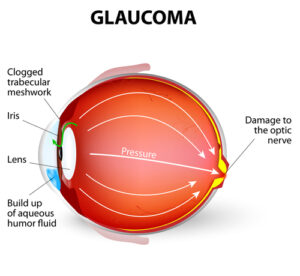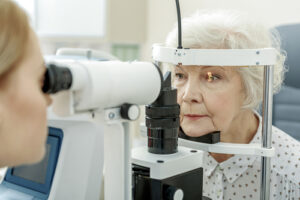Are you experiencing vision loss? Do you know what glaucoma is, but you’re not sure if you could have it?
Glaucoma is one of the leading causes of blindness, yet many people are unaware they have it. In its early stages, glaucoma has few discernible or noticeable symptoms.
Patients may notice mild symptoms like halos and light sensitivity while it’s developing. The problem is that they may be unaware of what’s causing them.
The damage is irreversible by the time it progresses to significant vision loss. However, you can stop glaucoma from reaching that point.
Keep reading to learn about glaucoma, its treatments, and how you can prevent it from severely impacting your vision!
What Is Glaucoma?

Glaucoma is an eye condition that damages your optic nerve. Your optic nerve is a group of over a million nerve fibers responsible for transporting messages to the brain.
Glaucoma is typically caused by a buildup of pressure in the eye. The buildup of pressure is referred to as intraocular pressure.
It’s necessary to understand how fluids drain from the eye before understanding how pressure buildup can occur. Your eyes produce fluid at all times.
The fluid must flow through the drainage network to maintain a healthy level. Glaucoma can result from a blockage in this network or an overproduction of fluid.
Who Develops Glaucoma?

Glaucoma is most common in older adults, specifically those who are at least sixty years old. Approximately three million Americans have some form of glaucoma.
Individuals with a family history of glaucoma, who have diabetes, or are of African descent are considered at higher risk for developing this condition at some point in their lives. One of the essential aspects to know about glaucoma is its gradual development.
It can progress slowly over time, with many patients unaware they even have it in the early stages. Symptoms can start with blind spots, most frequently in your peripheral vision.
If left untreated, they can then advance to tunnel vision and permanent vision loss.
Are There Different Kinds of Glaucoma?
The most common form of glaucoma is open-angle glaucoma. Most patients who have glaucoma have this form.
As you age, the drainage system in your eye can become partially blocked. As a result, pressure increases, causing damage to the optic nerve.
The other most common form of glaucoma is called angle-closure glaucoma. With angle-closure glaucoma, the drainage angle is too narrow and compromises the fluid’s ability to flow outwards from the eye.
The increase of pressure associated with this type of glaucoma is more sudden. Symptoms include experiencing intense headaches, eye pain, nausea, and vomiting.
Although less common, there are a few other types of glaucoma:
Normal tension-glaucoma
Damage occurs although eye pressure remains normal.
Secondary glaucoma:
Pressure results from an existing condition like cataracts or diabetes.
Pigmentary glaucoma
Bits of the iris flake off and collect in the drainage system.
No matter what kind of glaucoma you have, it’s necessary to seek early treatment to avoid further vision loss.
The Importance of Early Detection of Glaucoma
Once glaucoma damages your optic nerve, the effects are permanent. Unfortunately, there is no way to get your vision back. If you have glaucoma, the damage that it causes is entirely irreversible.

Many people are not even aware they have glaucoma until they experience advanced symptoms. Early detection and treatment are crucial to avoiding vision loss.
Be sure to keep up with regular eye exams so that your eye doctor can evaluate you for potential signs of glaucoma you may not be noticing. It is only possible to maintain healthy vision through diagnosis and treatment of glaucoma.
How Is Glaucoma Treated?
The goal of glaucoma treatment is to lower intraocular pressure. There are a variety of treatments available aimed at accomplishing this.
Multiple treatment methods are often combined for the most effectiveness. Medication is often the first method of treatment.

Many eye doctors start their glaucoma patients off with eye drops. Glaucoma eye drops aim to lower and stabilize rates of intraocular pressure.
Besides eye drops, there are several different types of medications available. Your eye doctor will use your medical history and information about the kind of glaucoma you have to make the best recommendation.
One medication is alpha-adrenergic agonists. Alpha-adrenergics work to decrease fluid production and increase its outward flow.
Beta-blockers are another option that decreases fluid production and how fluids flow into the eye. Lastly, prostaglandin analogs increase the speed that fluid flows out of the eye.
When further efforts are needed to protect against vision loss, your eye doctor may recommend laser surgery. Laser surgeries are more sophisticated glaucoma procedures that help reduce fluid drainage from the eyes.
During the procedure, your surgeon will use an ultra-precise laser to help aid the process of fluid drainage. Depending on the individual case, you may still need to take medication after surgery.
The most common kinds of laser surgery to treat glaucoma are:
Selective laser trabeculoplasty
Selective laser trabeculoplasty opens the drainage area by creating less scar tissue with minimal pain.
Laser peripheral iridotomy
Laser peripheral iridotomy creates a tiny hole in the eye to allow fluid to flow through the eye better. Exposing the trabecular meshwork helps to enhance how fluid flows through the eye.
It is a standard laser procedure used to treat closed-angle glaucoma.
Scatter panretinal photocoagulation
Scatter panretinal photocoagulation aims to lower fluid production and improve fluid movement throughout the eye.
Traditional surgery is also a treatment option. Types include:
Trabeculectomy
A trabeculectomy involves creating a new drainage pathway to improve how fluid can drain and move in the eye.
Peripheral iridectomy
A peripheral iridectomy creates small openings in the iris by removing a small amount of peripheral iris through a limbal incision.
Implant devices
Various implant devices have specific designs to lower intraocular pressure and help improve the flow of fluid in the eye.
How your eye doctor will choose to treat glaucoma will depend on the severity of your symptoms, intraocular pressure, and what kind of glaucoma you have.
Do you have more questions or concerns about glaucoma? Schedule an appointment at Cheema MD Eye Care in Kingston, NY, today!



